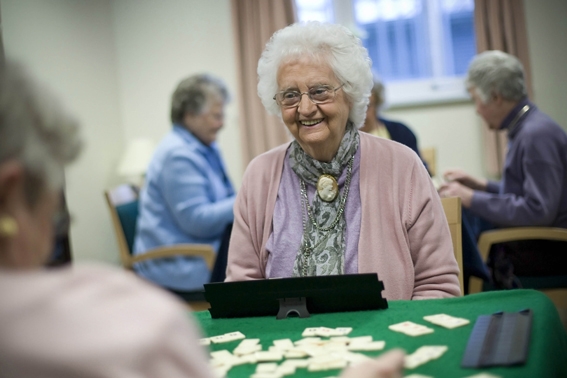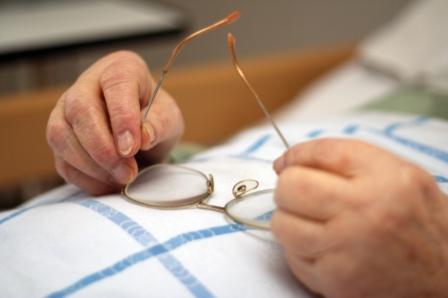This page provides evidence, guidance and resources to help improve care for people with sensory loss in care homes.
The Numbers
By 2032, there will be an estimated 620,000 people living in England’s care homes [1]. Of these, half are expected to have some form of sight loss, and an estimated three quarters will have hearing loss [2,3]. Dual sensory loss will also be high: the number of people over 70 with combined sight and hearing loss by 2030 is estimated to reach 418,000 [4]. In residential care, where there are high numbers of people with some form of dementia, there are additional issues identifying and managing sight and hearing problems, as there are some similar symptoms, such as communication difficulties and confusion [5].
People with learning disabilities are ten times more likely to have serious sight problems than other people. As people with learning disabilities get older, or if their learning disability is more profound, their risk of serious sight problems increases. For example, it is estimated that over 46,000 people with learning disabilities over 50 (in England) are living with visual impairment or blindness and over 190,000 will have refractive error enough to need glasses. [6]
The Challenges
Despite this, sensory loss is often a hidden issue, as people with sight or hearing impairment may not recognise it themselves and it is often thought of as an inevitable part of ageing. Although sight and hearing impairments are different issues and have their separate challenges, there are many shared issues, such as a lack of awareness and poor management, and that they can potentially be remedied with small, low cost solutions.
Our Initiative
A group of interested parties are working in partnership to address these issues. The organisations involved are: Action on Hearing Loss, Alzheimer’s Society, Care England, International Longevity Centre-UK, Thomas Pocklington Trust, RNIB, Sense, SeeAbility and Federation of Ophthalmic and Dispensing Opticians (FODO).
This group’s aims include:
- raising the profile of the issue of sight and hearing issues in care home residents
- raising awareness of the issue among residents, families, care staff and other health and social care professionals
- providing information about the many ways that health and quality of life can be improved for these individuals, often with low cost adjustments to the care environment
More information, including evidence, guidance and resources for care home staff, families and health and social care professionals, are available below.
If you are interested in getting involved with this campaign, please contact Jenny Sykes via research@pocklington-trust.org.uk.
Useful websites:
Thomas Pocklington Trust
Action on Hearing Loss
RNIB
Sense
Sight tests at home
SeeAbility
Supporting people who have Sight and Hearing Loss:
Enjoy life (Sense guide for families on dual sensory loss)
Seeing Me (Sense guide for care home staff on working with people with dual sensory loss)
Supporting people who have Sight Loss:
Seeing it from their side (RNIB guide to recognising and supporting sight loss in your care home
Who has poor sight in your home? (Thomas Pocklington Trust)
Older people (RNIB)
Bulletin – Quality of life for residents with sight loss (My Home Life)
Supporting people who have Hearing Loss:
Helping you care for people with hearing loss (Action on Hearing Loss)
Supporting people with dementia and sensory loss:
Dementia Gateway – including learning resources about caring for people with dementia and sensory loss (SCIE)
Sight, perception and hallucinations (Alzheimer’s Society)
Communicating – including Tips on communicating with someone with dementia and hearing loss (Alzheimer’s Society)
Low Expectations: Attitudes on choice, care and community for people with dementia in care homes
Your guide to selecting a care home
This is me leaflet – tool for people with dementia and their carers to help personalise care (Alzheimer’s Society)
Factsheet for people living with dementia, carers and professionals, on eye examinations
Factsheet for people living with dementia, carers and professionals on wearing glasses with dementia
Supporting people who have learning disabilities and sight loss
Factsheets on being aware of vision issues for people with learning disabilities, supporting people to have an eye test, understanding why people need to wear glasses and their prescriptions at
Easy read information for people with learning disabilities on eye care and vision can also be downloaded
Guidance for health and social care professionals;
Quality statement 4: Recognition of sensory impairment (NICE – National Institute for Health and Care Excellence)
Identification of deafblind dual sensory impairment in older people (SCIE – Social Care Institute for Excellence)
Focussed intervention Training and Support (FITS) (Alzheimer’s Society training programme)
Fill in the Gaps (Sense guide for social workers on dual sensory loss)
Proposed standards / recommendations for care homes (Action on Hearing Loss)
Older people: resources for professionals (RNIB)
Enhancing the healing environment – A guide to improve the environment where care is delivered (King’s Fund)
Personalisation briefing: Implications for nursing homes (SCIE)
Personalisation briefing: Implications for residential care homes (SCIE)
Activity Provision – Benchmarking good practice in care homes (College of Occupational Therapists)
Tailored resource for managers of care homes for older people
Prioritising quality personalised individual eye care in residential/care settings
Using NICE quality standards to improve practice: A resource for managers of care homes for older people
Tailored resource for managers of care homes for older people – mental wellbeing of older people in care homes
Mental wellbeing of older people in care home film
Managing medicines inc are homes: checklist for care home medicine policy
Research highlighting the issues:
A world of silence: The case for tackling hearing loss in care homes (Action on Hearing Loss)
Quality of life for residents with hearing loss (Action on Hearing Loss / Age Cymru / My Home Life)
Joining Up: Why people with hearing loss or deafness would benefit from an integrated response to long-term conditions such as dementia (Action on Hearing Loss)
“I don’t hear or see so well these days” (Sense)
The identification and assessment of the needs of older people with combined hearing and sight loss in residential homes (Sense and University of Birmingham)
Older people and sight loss: RNIB research
RNIB other sight loss research
Undetected sight loss in care homes: an evidence review (International Longevity Centre-UK)
Low expectations: attitudes on choice, care and community for people with dementia in care homes (Alzheimer’s Society)
Dementia and Sight Loss Interest Group (Vision 2020 UK)
Research discussion paper on models of change in care homes
Accessible Information
The Accessible Information Standard
References:
[1] King D, Malley J, Wittenberg R, Darton R, Comas-Herrera A, Projections of demand for residential care for older people in England, PSSRU, 2010.
[2] Royal National Institute of Blind People (2010) Seeing it from their side: A guide to recognising and supporting sight loss in your care home.
[3] Figures based on the application of prevalence figures for people with a hearing loss of >=35dB in the better ear derived from Davis, A. (1995), Hearing in Adults, Medical Research Council, London and applied to population figures, Office for National Statistics, 2009.
[4] Sense website. Information for professionals [Accessed March 2014]
[5] Alzheimer’s Society. Sight, perception and hallucinations in dementia [Accessed March 2014]
[6] Emerson and Robertson, 2011. The estimated prevalence of visual impairment among people with learning disabilities in the UK. https://www.seeability.org/who-we-are/media-centre/research/prevalence-of-visual-impairment
Two case studies that show how the well-being of residents improves when staff understand how to respond to dementia and sensory loss. Download below: Case studies Steve and Amy
A case study that shows the importance of regular eye tests and the correct glasses for residents living with dementia. Dwonload below: Case Study – Margaret.
– Optical Confederation Code of Practice letter 2014




Comments
Login/Register to leave a comment